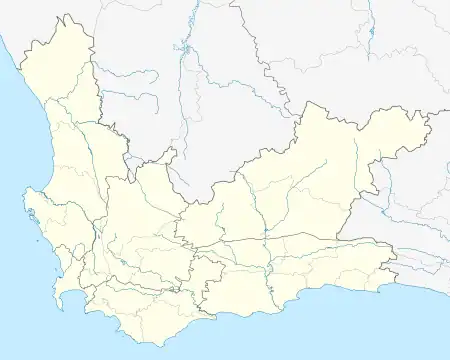Wellington, South Africa
Wellington is a town in the Western Cape Winelands, a 45-minute drive from Cape Town, in South Africa with a population of approximately 62,000. Wellington's economy is centered on agriculture such as wine, table grapes, deciduous fruit, and a brandy industry. The town is located 75 km north-east of Cape Town, reached by the N1 motorway and R44. Due to the growth of the Flakkaland and Mbekweni township south of the town, it now forms a de facto urban unit with Paarl, just 10 km to the south. Wellington now officially falls under the Drakenstein Local Municipality, which also covers Saron and Paarl.
Wellington | |
|---|---|
From top, Wellington CBD, with the NG Mother Church and snowy Wemmershoek Peak beyond. Dutch Reformed Church Complex in Wellington (centre left). Lady Loch Bridge over the Berg River (centre right). Coronation Arch in Victoria Jubilee Park (bottom left). Second Boer War block house (bottom right). | |
 Wellington  Wellington | |
| Coordinates: 33°38′S 18°59′E | |
| Country | South Africa |
| Province | Western Cape |
| District | Cape Winelands |
| Municipality | Drakenstein |
| Established | 1840[1] |
| Area | |
| • Total | 30.16 km2 (11.64 sq mi) |
| Population (2011)[2] | |
| • Total | 55,543 |
| • Density | 1,800/km2 (4,800/sq mi) |
| Racial makeup (2011) | |
| • Black African | 16.2% |
| • Coloured | 67.3% |
| • Indian/Asian | 0.4% |
| • White | 15.4% |
| • Other | 0.6% |
| First languages (2011) | |
| • Afrikaans | 81.2% |
| • Xhosa | 10.7% |
| • English | 5.9% |
| • Other | 2.1% |
| Time zone | UTC+2 (SAST) |
| Postal code (street) | 7655 |
| PO box | 7654 |
| Website | Wellington Tourism |
Location
Wellington is situated at the foot of the Groenberg on the banks of the Kromme Rivier (Dutch for Crooked River) and forms the centre of the Cape Winelands with its picturesque environment and numerous wineries. The town is at the base of one of the oldest mountain passes in South Africa, Bain's Kloof Pass, built by master road-builder Andrew Geddes Bain. The town is the home of the Boland Rugby Union and the professional rugby team the Boland Kavaliers. The town is also an academic centre, with Cape Peninsula University of Technology, Timothy Ministry Training, Bible Media, Huguenot High School, Weltevrede Senior Secondary School, and Bergriver Senior Secondary School all falling within the town.
Etymology
Originally known as Limiet Valley (border or frontier valley), the area became known as Val du Charron or Wagenmakersvallei (Valley of the Wagonmaker) toward the end of the seventeenth century when the French Huguenots settled there. After the formal establishment of the town in 1840, the name was changed to Wellington in honour of the Arthur Wellesley, 1st Duke of Wellington, renowned soldier and conqueror of Napoleon at the Battle of Waterloo, as suggested by Sir George Napier.[3]
Coats of arms
Municipality (1) — Wellington was a municipality in its own right from 1873 to 2000. On 18 June 1918, the town council adopted a pseudo-heraldic design as the municipal arms.[4] The shield was blue, and contained a landscape scene in a circular border. The shield was supported by two red lions, each with a golden coronet around its neck (these being the supporters of the arms of the Duke of Wellington). The arms were depicted on a cigarette card issued in 1931.[5]
Municipality (2) — On 22 June 1948, the council approved a new coat of arms, designed by Ivan Mitford-Barberton and H. Ellis Tomlinson.[6] This was in response to a Cape Provincial Administration circular calling on municipalities to have their arms checked and, if necessary, re-designed to make them heraldically correct. The arms were registered at the Bureau of Heraldry in February 1987.[7]
The design reflected the Huguenot origins of the town: Per chevron Argent and Azure, in chief two hurts, each charged with a fleur-de-lis Or, in base a Huguenot cross, Argent (in layman's terms : the shield is divided into silver over blue by a chevron-shaped line, in the upper half are two golden fleurs de lis on blue discs and in the lower half is a silver Huguenot cross). A blue mural crown was added as a crest. The existing supporters were retained, but were differenced by adding a silver anchor to the coronet. The motto was "Par foi et loyaute".
Notable Sites
Established in 1886, the James Sedgewick Distillery is located in Wellington, and produces the Three Ships range of whiskies, as well as the single grain Bain's Cape Mountain Whisky.
References
- Robson, Linda Gillian (2011). "Annexure A" (PDF). The Royal Engineers and settlement planning in the Cape Colony 1806–1872: Approach, methodology and impact (PhD thesis). University of Pretoria. pp. xlv–lii. hdl:2263/26503.
- "Main Place Wellington". Census 2011.
- "Wellington Guide". Wellington Tourism. Retrieved 18 June 2012.
- Western Cape Archives : Wellington Municipal Minutes (18 June 1918).
- "Category:UTC South African town arms - (Heraldic collector's items)".
- Western Cape Archives : Wellington Municipal Minutes (22 June 1948).
- National Archives of South Africa : Data of the Bureau of Heraldry





.svg.png.webp)